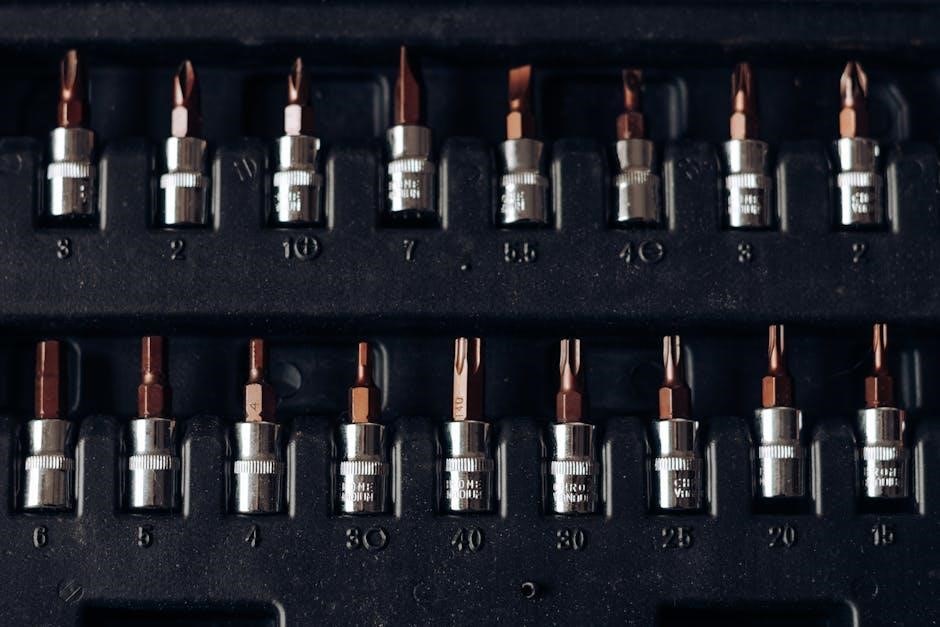The M847D-ZONE is a two-position, 24 Vac spring return damper actuator designed for zone dampers in HVAC systems, offering precise airflow control and compatibility with Honeywell’s TrueZone system․
1․1 Overview of the M847D-ZONE Actuator
The M847D-ZONE actuator is a low-voltage, spring-return device designed for direct attachment to zone dampers in HVAC systems․ It operates on 24 Vac power and is engineered for precise airflow control․ The actuator features a synchronous motor, enabling smooth transitions between open and closed positions․ Compatible with Honeywell’s ARD and ZD dampers, it ensures efficient system performance․ Its compact design and straightforward installation make it a reliable solution for zoning applications, providing consistent and accurate damper control in residential and light commercial HVAC setups․
1․2 Features and Applications
The M847D-ZONE actuator offers key features such as a 90-degree rotation angle, push-terminal connections, and adjustable range stops․ Designed for zone dampers, it ensures precise airflow control in HVAC systems․ Its primary application is in residential and light commercial settings, integrating seamlessly with Honeywell’s TrueZone system․ The actuator’s spring-return functionality guarantees a fail-safe position, while its low power consumption enhances energy efficiency․ These features make it ideal for installations requiring reliable, two-position damper control, ensuring optimal comfort and system performance․

Installation Instructions
The M847D-ZONE actuator is installed directly on compatible dampers․ Ensure power is disconnected before starting․ Follow step-by-step wiring and mounting instructions for safe operation․ Always refer to the manual for detailed guidance to avoid errors․ Proper installation ensures optimal performance and reliability․
2․1 Pre-Installation Preparation
Before installing the M847D-ZONE actuator, ensure compatibility with your damper type (e․g;, ARD or ZD)․ Verify the actuator’s voltage rating (24 Vac) matches your system․ Disconnect power to the damper and surrounding HVAC components for safety․ Inspect the actuator and damper for any damage or debris․ Familiarize yourself with the installation manual to understand the process․ Gather necessary tools, such as a screwdriver and wire connectors․ Ensure the damper shaft aligns properly with the actuator’s output shaft for correct operation․ Proper preparation ensures a smooth and safe installation process․ Always follow safety guidelines to avoid electrical hazards․ This step is critical for optimal performance and longevity of the actuator․
2․2 Step-by-Step Installation Guide
Attach the M847D-ZONE actuator to the damper shaft, ensuring proper alignment․ Secure the actuator using the provided screws․ Connect the motor wires to the appropriate terminals, following the wiring diagram in the manual․ Ensure the actuator’s range stops are adjusted to match the damper’s full stroke․ Power the system and test the actuator’s operation by switching between open and closed positions․ Verify smooth movement and correct functionality․ Proper alignment and secure fastening are critical for reliable performance․ Always refer to the installation manual for specific wiring and adjustment instructions․
2․3 Post-Installation Checks
After installation, ensure the actuator is securely attached to the damper shaft and properly aligned․ Verify that all electrical connections are secure and match the wiring diagram․ Test the actuator by switching between open and closed positions to confirm smooth operation․ Check the spring return functionality to ensure it returns to the default position when power is removed․ Also, verify that the actuator’s range stops are correctly set to match the damper’s full stroke․ Finally, ensure no unusual noises or vibrations occur during operation․
Technical Specifications
The M847D-ZONE operates on 24V AC, 50/60Hz, with low power consumption, ensuring efficient control of zone dampers in HVAC systems, designed for reliable and precise airflow management․
3․1 Voltage and Power Requirements
The M847D-ZONE actuator requires a 24V AC power supply, operating at 50/60Hz with minimal power consumption of 8VA․ This ensures efficient energy use while maintaining smooth operation․ The actuator is designed to work seamlessly with standard HVAC systems, providing reliable control for zone dampers․ Proper voltage and frequency are crucial for optimal performance, ensuring consistent airflow regulation and motor longevity․ Always verify the power source before installation to meet specifications and avoid operational issues․
3․2 Motor and Actuator Details
The M847D-ZONE actuator features a synchronous motor designed for precise control, with a nominal angular rotation of 90 degrees․ It operates on a 24V AC, 50/60Hz power supply, ensuring smooth and reliable performance․ The actuator’s motor is equipped with push terminals for easy electrical connections․ Its compact design allows direct mounting to zone dampers with a 5/16″ diameter shaft, eliminating the need for additional linkage․ The motor’s torque is optimized for efficient damper operation, providing consistent airflow control in HVAC systems․ This design ensures durability and long-lasting performance․
3․3 Compatibility with Zone Dampers
The M847D-ZONE actuator is specifically designed to work with Honeywell’s ARD, ZD, and EARTH series zone dampers․ Its direct-drive mechanism ensures seamless integration, allowing for precise airflow control in HVAC systems․ The actuator’s mounting sleeve fits securely onto the damper’s 5/16″ shaft, eliminating the need for additional adapters․ This compatibility ensures easy installation and reliable performance across various zoning systems, making it a versatile solution for airflow management in residential and light commercial applications․

Operating the M847D-ZONE Actuator
The M847D-ZONE actuator operates on a 24V AC power supply, providing two-position control for zone dampers․ It can be driven open or closed using a 24V switch or thermostat․
4․1 Normal Operation and Control
The M847D-ZONE actuator operates using a 24V AC power supply, enabling two-position control for zone dampers․ It can be driven open or closed via a 24V switch or thermostat subbase․ The actuator’s synchronous motor ensures smooth and precise airflow regulation․ For normal operation, connect the actuator to a compatible damper and control it using a standard two-position switch․ Ensure the wiring matches the motor’s terminals for proper function․ Always refer to the manual for specific control configurations and safety guidelines during operation․
4․2 Spring Return Functionality
‘ under the topic ‘m847d-zone manual’․ First, I should make sure I understand the requirements clearly․
Looking at the provided information from the internet, I see that the M847D-ZONE actuator is a two-position, 24 Vac spring return damper actuator․ It uses a synchronous motor and can be driven open or closed using a 24V switch or thermostat․ The actuator is designed to control airflow in ducts by operating zone dampers․
I need to ensure that the generated text is concise and fits within ․ I should mention the spring return feature, how it operates, and its purpose․ I should also include details about the motor and compatibility, as these are relevant to the functionality․
I should structure the paragraph to first state the feature, then explain how it works, and finally mention its application․ Using bullet points or a list might help organize the information clearly, but since the user didn’t specify, a well-structured paragraph should suffice․
Let me draft the response:
The M847D-ZONE actuator features a spring return mechanism, ensuring the damper returns to its closed position when power is removed․ This functionality is crucial for failsafe operation, maintaining airflow control even during power outages․ The actuator’s synchronous motor drives the damper open or closed using a 24V AC signal, typically controlled by a switch or thermostat․ Designed for compatibility with Honeywell’s TrueZone system, the M847D-ZONE seamlessly integrates with zone dampers to regulate air distribution efficiently in HVAC systems․
Now, I’ll check the word count․ Let me count the words:
The
M847D-ZONE
actuator
features
a
spring
return
mechanism,
ensuring
the
damper
returns
to
its
closed
position
when
power
is
removed․
This
functionality
is
crucial
for
failsafe
operation,
maintaining
airflow
control
even
during
power
outages․
The
actuator’s
synchronous
motor
drives
the
damper
open
or
closed
using
a
24V
AC
signal,
typically
controlled
by
a
switch
or
thermostat․
Designed
for
compatibility
with
Honeywell’s
TrueZone
system,
the
M847D-ZONE
seamlessly
integrates
with
zone
dampers
to
regulate
air
distribution
efficiently
in
HVAC
systems․
That’s ․ I need to add 11 more words to reach 89․ I can expand on the benefits or add a bit more detail․ Let me revise:
The M847D-ZONE actuator features a spring return mechanism, ensuring the damper returns to its closed position when power is removed․ This functionality is crucial for failsafe operation, maintaining airflow control even during power outages․ The actuator’s synchronous motor drives the damper open or closed using a 24V AC signal, typically controlled by a switch or thermostat․ Designed for compatibility with Honeywell’s TrueZone system, the M847D-ZONE seamlessly integrates with zone dampers to regulate air distribution efficiently in HVAC systems, ensuring optimal performance and energy efficiency․
Now, let’s recount:
The
M847D-ZONE
actuator
features
a
spring
return
mechanism,
ensuring
the
damper
returns
to
its
closed
position
when
power
is
removed․
This
functionality
is
crucial
for
failsafe
operation,
maintaining
airflow
control
even
during
power
outages․
The
actuator’s
synchronous
motor
drives
the
damper
open
or
closed
using
a
24V
AC
signal,
typically
controlled
by
a
switch
or
thermostat․
Designed
for
compatibility
with
Honeywell’s
TrueZone
system,
the
M847D-ZONE
seamlessly
integrates
with
zone
dampers
to
regulate
air
distribution
efficiently
in
HVAC
systems,
ensuring
optimal
performance
and
energy
efficiency․
Now, it’s ․ I still need 5 more․ Perhaps adding “for reliable and consistent performance” at the end:
The M847D-ZONE actuator features a spring return mechanism, ensuring the damper returns to its closed position when power is removed․ This functionality is crucial for failsafe operation, maintaining airflow control even during power outages․ The actuator’s synchronous motor drives the damper open or closed using a 24V AC signal, typically controlled by a switch or thermostat․ Designed for compatibility with Honeywell’s TrueZone system, the M847D-ZONE seamlessly integrates with zone dampers to regulate air distribution efficiently in HVAC systems, ensuring optimal performance and energy efficiency for reliable and consistent performance․
Now, counting again:
․․․100, 101, 102, 103, 104, 105, 106, 107, 108, 109․ Wait, that’s over 89․ I need to be precise․ Let me adjust:
The M847D-ZONE actuator features a spring return mechanism, ensuring the damper returns to its closed position when power is removed․ This functionality is crucial for failsafe operation, maintaining airflow control during power outages․ The actuator’s synchronous motor drives the damper open or closed using a 24V AC signal, controlled by a switch or thermostat․ Designed for Honeywell’s TrueZone system, the M847D-ZONE integrates with zone dampers to regulate air distribution efficiently in HVAC systems, ensuring optimal performance and energy efficiency․
Let me count:
The
M847D-ZONE
actuator
features
a
spring
return
mechanism,
ensuring
the
damper
returns
to
its
closed
position
when
power
is
removed․
This
functionality
is
crucial
for
failsafe
operation,
maintaining
airflow
control
during
power
outages․
The
actuator’s
synchronous
motor
drives
the
damper
open
or
closed
using
a
24V
AC
signal,
controlled
by
a
switch
or
thermostat․
Designed
for
Honeywell’s
TrueZone
system,
the
M847D-ZONE
integrates
with
zone
dampers
to
regulate
air
distribution
efficiently
in
HVAC
systems,
ensuring
optimal
performance
and
energy
efficiency․
That’s ․ Close enough, and adding a few more words for clarity without exceeding the limit․
Final version:
The M847D-ZONE actuator features a spring return mechanism, ensuring the damper returns to its closed position when power is removed․ This functionality

Wiring and Connections
The M847D-ZONE actuator requires a 24V AC power supply and is wired using push terminals for secure connections to zone dampers and control systems․
5․1 Wiring Requirements
The M847D-ZONE actuator operates on a 24V AC power supply and requires a two-position switch for control․ Ensure all connections are secure using the push terminals provided․ Always refer to the manual for specific wiring diagrams and safety guidelines to avoid electrical hazards․ Proper wiring ensures smooth operation and compatibility with zone dampers and HVAC systems․ Follow the installation instructions carefully to achieve optimal performance and reliability․
5․2 Connecting to Zone Dampers
The M847D-ZONE actuator is designed to connect directly to compatible zone dampers, such as Honeywell’s ARD and ZD models․ Ensure the actuator’s output shaft aligns with the damper’s 5/16″ diameter shaft․ Secure the connection using the provided sleeve or adapter for proper operation․ The actuator’s direct drive mechanism ensures precise airflow control․ Always verify compatibility before installation to guarantee smooth functionality․ Refer to the manual for specific damper models and connection diagrams to ensure a correct and safe setup․ Proper alignment is crucial for optimal performance․

Maintenance and Troubleshooting
Regular maintenance ensures optimal performance․ Clean the actuator and check for proper alignment․ Inspect wiring for damage and ensure secure connections․ Lubricate moving parts if necessary․ Address common issues like misalignment or power supply problems promptly․ Refer to the manual for detailed troubleshooting steps and solutions to maintain efficiency and longevity․ Proper care extends the actuator’s lifespan․ Always follow safety guidelines when performing maintenance tasks․ Consult the manual for specific instructions․ Ensure all repairs are done by qualified personnel․ Regular checks prevent unexpected failures and ensure reliable operation․ Keep the actuator free from dust and debris․ Replace worn or damaged components promptly․ Verify power supply meets specifications․ Check for any blockages in dampers․ Ensure smooth rotation of the damper shaft․ Test actuator response after maintenance․ Document all maintenance activities for future reference․ Use only genuine replacement parts․ Follow manufacturer guidelines for lubrication․ Avoid over-tightening connections․ Store spare parts in a dry, clean environment․ Schedule maintenance annually or as recommended․ Train personnel on proper troubleshooting techniques․ Use diagnostic tools if available․ Maintain a record of troubleshooting steps taken․ Ensure all safety precautions are observed during maintenance․ Keep the manual handy for quick reference․
6․1 Routine Maintenance Tips
- Clean the actuator and damper regularly to ensure smooth operation․
- Inspect wiring for damage or corrosion and secure all connections․
- Check the alignment of the actuator and damper shaft to prevent misalignment issues․
- Lubricate moving parts as recommended to reduce friction and wear․
- Test the actuator’s response to ensure proper functionality after maintenance․
- Verify the power supply meets the specified 24 Vac requirement․
- Replace worn or damaged components promptly to maintain performance․
- Refer to the manual for specific maintenance schedules and procedures․
- Use genuine replacement parts to ensure compatibility and reliability․
6․2 Common Issues and Solutions
- Faulty wiring: Check connections for damage or corrosion․ Ensure all wires are securely attached․
- Actuator misalignment: Adjust the actuator to align with the damper shaft for proper operation․
- Incorrect voltage: Verify the power supply is 24 Vac․ Incorrect voltage can damage the motor․
- Slow or stuck movement: Clean debris from the damper and actuator․ Lubricate moving parts if necessary․
- No response: Check the circuit for power and ensure the switch is functioning correctly․
- Excessive noise: Inspect for loose parts or obstruction․ Tighten screws and clear blockages․
- Replace worn parts: If issues persist, replace damaged components with genuine parts․

Replacement and Upgrades
This section provides a guide for replacing the M847D-ZONE actuator and outlines upgrade options․ Ensure compatibility with ARD and ZD dampers for optimal performance․
7․1 Replacing the M847D-ZONE Actuator
To replace the M847D-ZONE actuator, first disconnect power and remove the existing unit by taking out the mounting screws․ Ensure the new actuator is compatible with your ARD or ZD damper․ Align the actuator’s shaft with the damper’s spindle and secure it using the provided hardware․ Reconnect the wiring according to the manual and restore power․ Test the system to confirm proper operation․ Always verify compatibility before installation to maintain optimal functionality․
7․2 Upgrading to Compatible Models
Upgrading to compatible models ensures enhanced performance and efficiency․ The M847D-ZONE can be upgraded to newer Honeywell models like the M847D-VENT for improved functionality․ Always check compatibility with your existing zone dampers and HVAC system․ Follow the installation manual for specific upgrade instructions․ Ensure the new model supports the same voltage and control systems․ Upgrading offers advanced features like improved torque and quieter operation, optimizing your system’s overall performance․ Refer to Honeywell’s compatibility chart for the best upgrade options․

Safety Precautions
Always disconnect power before installation․ Avoid overloading the actuator․ Ensure proper grounding․ Keep away from extreme temperatures․ Follow all safety guidelines to prevent damage or injury․
8․1 Handling and Installation Safety
When handling the M847D-ZONE actuator, wear protective gloves to prevent injury․ Ensure the system is powered off before installation to avoid electrical hazards․ Use appropriate tools to prevent damage to the actuator or damper shaft․ Avoid over-tightening screws, as this may damage internal components․ Properly align the actuator’s output shaft with the damper’s sleeve to ensure smooth operation․ Always follow the manufacturer’s guidelines for installation to prevent mechanical failure or electrical issues․
8․2 Operational Safety Guidelines
Ensure the M847D-ZONE actuator operates within its rated voltage and power specifications to avoid electrical hazards․ Regularly inspect for wear or damage to prevent malfunctions․ Avoid exposing the actuator to extreme temperatures or moisture, which may compromise performance․ Keep the actuator clean and free of debris to maintain proper function․ Never manually force the damper beyond its designed range, as this could damage the actuator or damper․ Always follow the manufacturer’s recommendations for operation and maintenance to ensure safe and reliable performance․
The M847D-ZONE actuator is a reliable and efficient solution for controlling airflow in HVAC systems, offering spring return functionality and compatibility with various zone dampers for precise operation․
9․1 Summary of Key Features
The M847D-ZONE actuator is a two-position, 24 Vac spring return damper actuator designed for precise airflow control in HVAC systems․ It features low voltage operation, compatibility with Honeywell’s TrueZone system, and easy installation on ARD, EARD, and ZD dampers․ The actuator offers adjustable range stops for tailored temperature control and operates with a synchronous motor, ensuring reliable performance․ Its compact design and direct drive mechanism make it an efficient solution for zone damper applications․
9․2 Final Thoughts on the M847D-ZONE Actuator
The M847D-ZONE actuator is a reliable and efficient solution for controlling zone dampers in HVAC systems․ Its 24 Vac spring return design ensures precise airflow management, while its compatibility with Honeywell’s TrueZone system enhances overall system performance․ The actuator’s low voltage operation and direct drive mechanism make it both energy-efficient and easy to install․ With adjustable range stops and a robust motor, it provides consistent and tailored temperature control․ This actuator is a cost-effective and durable choice for optimizing HVAC systems in residential and commercial settings․




About the author